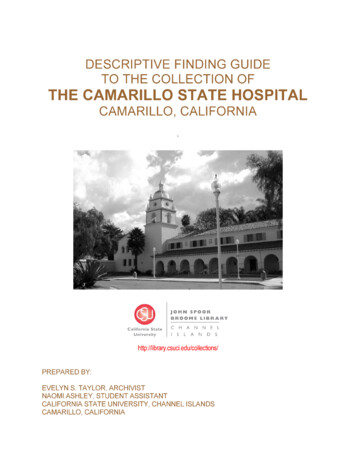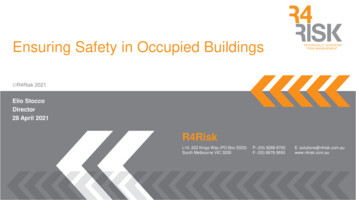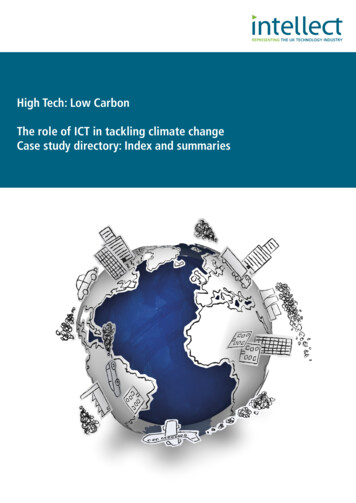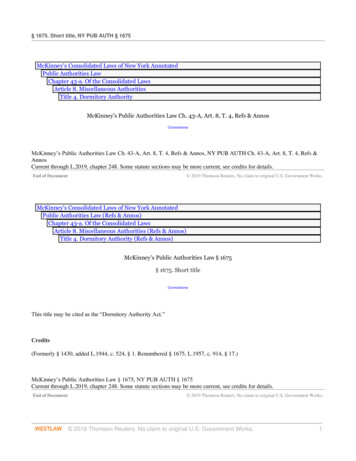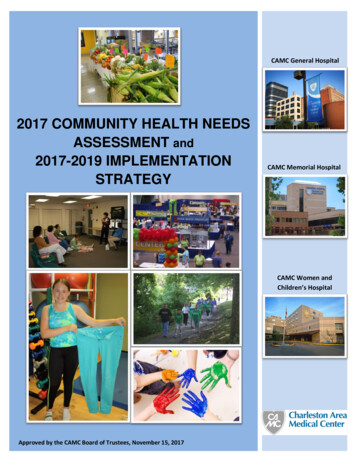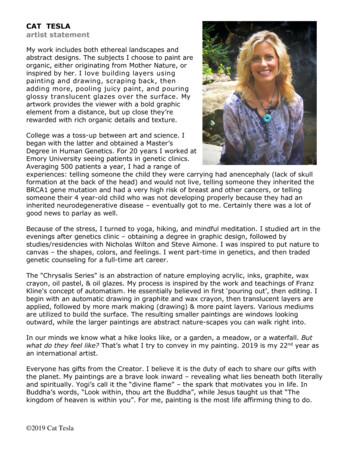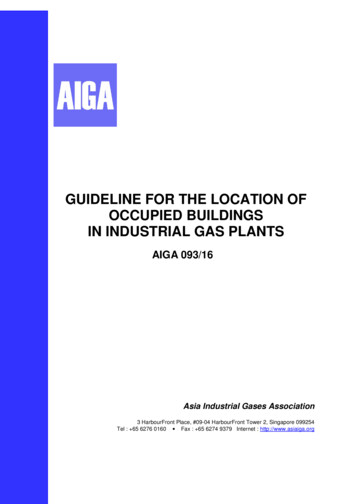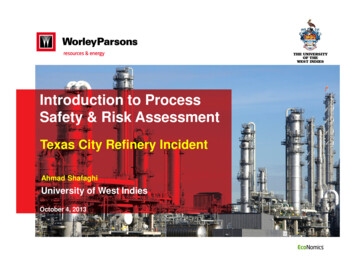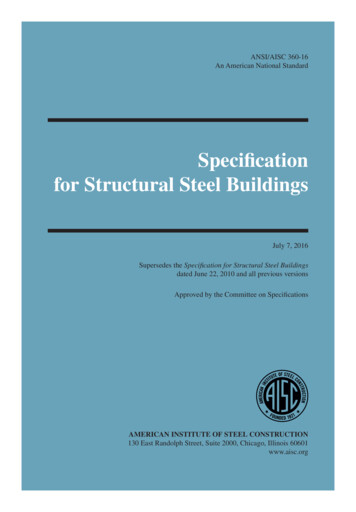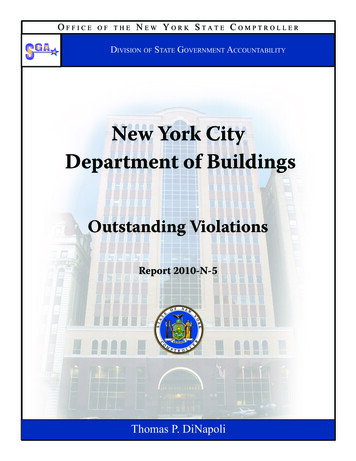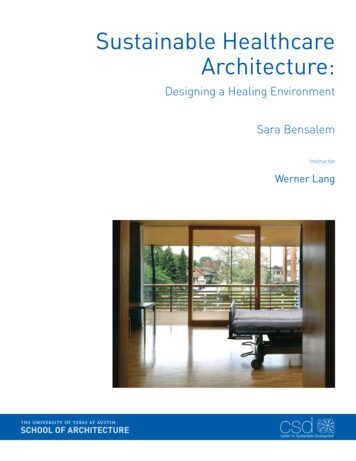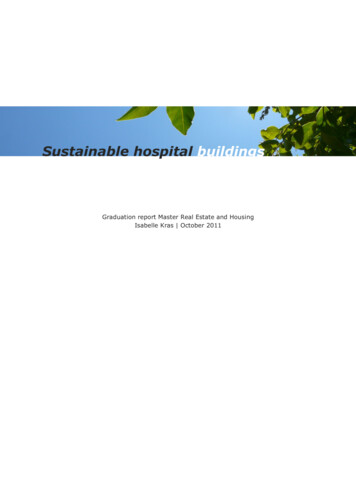
Transcription
Sustainable hospital buildingsGraduation report Master Real Estate and HousingIsabelle Kras October 2011
Title:Sustainable hospital buildingsMaster:Technical University of DelftFaculty of Architecture, Urbanism and Building SciencesDepartment of Real Estate and HousingCorporate Real Estate Management laboratoryFirst mentor:Second mentor:External examiner:Dr. ir. D.J.M. van der VoordtProf. dr. ir. A.A.J.F. van den DobbelsteenIr. R.P. GeraedtsGraduation Company:Mentor:Twynstra GuddeIr. M.A. SijpesteinStudent:Student#:Contact:I.M.C. Kras4049578isabellekras@hotmail.com2Sustainable hospital buildings
PREFACEAfter obtaining my bachelors degree of Architecture, Building and Planning at theTechnical University of Eindhoven, this master thesis of the master Real Estate andHousing of the Technical University of Delft is my finishing study project. The mastertrack of Real Estate and Housing consists of three specializations and this research isdone within the field of Real Estate Management.The research topic for this master thesis is sustainability of hospital buildings.Sustainability has gained more and more interest in society and in the building sector.The built environment accounts for 40% of all CO2 emission in the Netherlands, sosustainable building has become an important issue. Hospitals alone count for 4% of thebuilt environment, hence there is a lot to gain. Therefore it is necessary that hospitalsfeel the urgency to undertake actions to reduce their CO2 emissions. The objective of thisresearch is give insight in the definition of sustainability and to demonstrate the addedvalue of sustainable real estate to the primary objectives of hospitals.I would like to thank Mr. Van der Voordt and Mr. Van den Dobbelsteen from theuniversity and Mr. Sijpestein from Twynstra Gudde for their guidance during thegraduation trajectory. For their input for this research I would like to thank allinterviewees. Furthermore I want to thank my family and close friends for their supportand help during the whole graduation period.Isabelle Kras,Reeuwijk, October 2011Sustainable hospital buildings3
4Sustainable hospital buildings
MANAGEMENT SUMMARYSustainability in the healthcare sector seems to be an evident goal. The healthcare sectoris a sector that is strongly changing, with trends rapidly following one another. However,sustainability is not really a part of these trends in the hospital sector yet.yet The objectiveof this research is to give insight in the definition of sustainability and to show howsustainable real estate can add value to the organization.To attain this objective the following problem statement is formulated:1. The comprehension of the concept of sustainability is the first problem;management boards find it is too vast a term, knowledge and awareness is notalways standby.2. The added value of (sustainable) real estate to the organization is unclear orquestioned.The hypothesis of the study is that a ganization which strives to provide a healingenvironment that subsequently is facilitated by thebuilding, as shown in figure 0.1.To research this literature study is done on threefields; hospitals, the added value of real estate andsustainability. Two hospitals that are currentlybuilding studied to investigate what hospitals areFigure 0.1 Hypothesis of the definitionalready doing on sustainability and two best off sustainable hospital buildingpractices in other sectors (office and hotel) arestudied to explore what hospitals could learn from them.Literature study shows that whereas the mission of the hospital is simple;simplto treatincoming patients, the organization of all processes inside the hospital is complex andcan be done according many different principles. For this research the functional zoningmethod is selected. The functional zoning method states that the hospitalhocan beorganized according to the different real estate functions; the hot floors (including(operating rooms and intensive care),care) the hotel-function,function, the office and the factory. Thisorganization makes it possible to compare (parts of) the hospital to the office and thehotel.The World Commission on Environment and Development defined sustainability asfollows: Sustainable development is development that meets the needs of the presentwithout compromising the ability of future generations to meet their own needs (WCED,1987, p.43). This is then worked out in different strategies and tools that make thedefinition more tangible. The maybe best known strategy is that of Elkington (1998) thetriple bottom line: people, planet and profit; which focuses not only on economicprosperity, but also on environmental quality and social justice.This is further worked out into sustainable aspects by different tools used for sustainablebuilding. A list of these tools and aspects can be found in table 5.6; the selected aspectsfor sustainable hospital building are shown in figure 0.2. Those aspects can becategorized into people, planet and profit and consequently have different units ofSustainable hospital buildings5
measurement and are therefore difficult to compare. When achieving measurements inall different aspects the ultimate sustainable building is realized. Preconditions areformulated by the links between people and planet, planet and profit and profit andpeople as formulated in the hypothesis, which was underpinned by the interviewees. Theorganization is corporate social responsible, patients and staff are in a healingenvironment and investment decisions are made according to the total costs ofownership.Figure 0.2 Defining sustainablehospital buildingThis scheme clarifies the definition by showing on the one hand the relation between theaspects to the different concepts of people, planet and profit and on the other hand theinterrelations between the concepts resulting in a sustainable hospital building.The second problem is answered by researching the literature on both sustainability andadded values of real estate. The selected aspects of sustainability are mentioned in figure0.2. De Vries (2007) demonstrates that real estate contributes to achievingorganization’s objectives and facilitating organizational performance, in table 4.1.Organizations objectives are productivity, profitability and comparative advantage (ordistinctiveness) (Tangen, 2005). Cross analyzing the sustainable aspects and the addedvalues of real estate resulted in table 0.1 and figure 0.3 demonstrating how thesustainable aspects add to the added values of real estate and therefore to theperformance criteria of the hospital. Taking the sustainable aspect health as example;this aspect is about comfort; acoustic, visual and thermal and indoor air quality.Achieving good ‘health’ contributes to the added values increasing user satisfaction,healing environment and supporting user activities. Another example is the aspect ofenergy which target is to reduce the energy use, therefore contributing to the valuedecreasing costs (for more explanation see §6.1).6Sustainable hospital buildings
ProfitxxxSupporting imageSupporting cultureSupporting user activitiesControlling risksIncreasing real estate valuexxxxxxxxxxxxFuture valueBuilding sizePerformance criteriaIncreasing ransportDecreasing costsxxHealing environmentHealthUser valueStimulating innovationIncreasing user satisfactionPeopleStimulating collaborationSustainable aspectsAdded values ofreal sTable 0.1 Relation between sustainable aspects and added valuesFigure 0.3 Relation scheme between sustainable aspects, added values and performance criteriaSustainable hospital buildings7
Figure 0.3 can be used on the one hand for showing how sustainability adds to theorganization's performance criteria. On the other hand it can be used for steering oncertain sustainable aspects as a derivative of important performance criteria or addedvalue of the organization. In this way the scheme serves as a model for managementboards indicating what performance criteria are important, from which sustainableaspects can be derived. It serves for real estate managers to check what sustainableaspects are important and contributes to the added values defined and for theenvironmental coordinator of the hospital who can show to the real estate manager andmanagement boards why measures within the presented sustainable aspects areimportant to take (see also figure 9.2 and appendix V-VII).To make the sustainable aspects defined more tangible, for each sustainable issue theultimate situation is defined by taking people, planet and profit apart and investigatingeach concept individually. This resulted in different solution fields for the sustainableaspects as shown in figure 0.4:Figure 0.4 Solution fields for the different sustainable aspects8Sustainable hospital buildings
The main lessons learned from the cases are that:1. Sustainability is perceived as an umbrella term.Talking about sustainability in practice is often about energy reduction. The planetside of sustainability (energy, water, waste, etc.) is concrete and can easily betranslated in measures that are technical and often related to installation systems.Costs and benefits are clear at starting time and decisions on measures are takenbased on the payback time of these measures.2. On the other hand healing environment is a more and more accepted and appliedtheory in hospitals. However, the link with sustainability or the people side ofsustainability is not really made.The idea that the (built) environment influences the well-being of people becomesmore accepted and hospitals are acting on this. The more abstract aspects as‘feeling at home’, distraction by view outside preferably on nature or the demandfor more tranquility are being discussed from the design phase on. Theenvironment can not only contribute to the healing process but also effects staffsatisfaction as working circumstances increase.3. Budget always seem to be the restricting factor to implement sustainablemeasures.Decisions on sustainable measures are based on the payback time of thesemeasures. This shows that investment costs are no longer leading and total costsof ownership become more important. Still, if budget needs to be cut, sustainablemeasures of which the benefits are not directly quantifiable in Euros are often thefirst to fail.From the office and hotel sector can be learned that:4. In both cases labels of internationally recognized assessment tools are used toindicate their ambitions and communicate the level of sustainability reached.Those labels are easy, recognizable communication tools that also permit tocompare the degree of sustainability of different buildings. In addition it forces theorganization to look at all aspects of sustainability instead of taking for exampleonly energy reducing measures. For hospitals it is not necessary to directly aim atthe highest level, but a label is a means to benchmark your own sustainability toother hospitals and can be used as communication tool for image purposes.Recommendations for practice are therefore:Make clear at the starting phase what a sustainable hospital is for your organization. Byusing figure 0.2 or such a picture that demonstrates sustainable aspects it is clear foreveryone what is meant with the term.Determine a sustainable strategy that fits with the overall strategy of the hospital. Themodel of figure 9.2 forms a good starting point to discuss sustainability with the differentstakeholders involved. In this model one can clearly see that performance criteria, addedvalues of real estate and the sustainable aspects are linked to each other. Implementingsustainable measures supporting the strategy of the hospital creates acceptance andmakes it therefore easier to actually perform those measures.Sustainable hospital buildings9
10Sustainable hospital buildings
CONTENTPreface 3Management summary 5Content 111. Introduction 152. Research design 172.1 Reason2.2 Problem statement2.3 Research objectives2.4 Hypothesis2.5 Research questions2.6 Relevance2.6.1 Scientific relevance2.6.2 Social relevance2.7 Research method3. Hospital characteristics 233.1 Hospital organization3.1.1 Organization on care process3.1.2 Organization on type of care3.1.3 Organization on target groups or diseases3.1.4 Functional zoning method3.2 Trends and developments3.2.1 Changing demand for real estate3.2.2 Flexibility3.2.3 Planetree3.2.4 Healing environment3.3 Conclusion4. Real estate management 314.1 Corporate Real Estate Management4.2 Added values of real estate4.3 Conclusion5. Sustainability 395.1 Sustainable strategies for organizations5.1.1 Triple bottom line5.1.2 Corporate Social Responsibility5.1.3 Triple top line5.2 Sustainable strategies for products (buildings)5.2.1 Cradle to cradle5.2.2 Three-stepped strategy5.3 Tools for sustainable building5.3.1 Ambition tool5.3.2 LCA based toolsSustainable hospital buildings11
5.3.3 Assessment tools5.4 Sustainability in hospital architecture5.4.1 Towards a carbon neutral hospital5.4.2 Health Care Without Harm5.4.3 Environmental thermometer5.5 Conclusion6. Added value of sustainable real estate 516.1 Sustainable aspects6.2 Added value and sustainability6.3 Performance criteria and sustainability6.4 CREM and sustainability7. Concepts for a sustainable hospital 597.1 People7.1.1 Possible solutions7.1.2 Concrete examples7.2 Planet7.2.1 Possible solutions7.2.2 Concrete examples7.3 Profit7.3.1 Possible solutions7.3.2 Concrete examples7.4 Solution fields per sustainable aspect8. Case studies 698.1 Meander Medical Centre8.1.1 New design8.1.2 Sustainability aspects8.1.3 Added values and sustainability8.1.4 Conclusion8.2 Isala Klinieken8.2.1 New design8.2.2 Sustainability aspects8.2.3 Added values and sustainability8.2.4 Conclusion8.3 TNT Green office8.3.1 New design8.3.2 Sustainability aspects8.3.3 Added values and sustainability8.3.4 Conclusion8.4 Hotel Amstelkwartier8.4.1 New design8.4.2 Sustainable initiatives for hotels8.4.3 Added values and sustainability8.4.4 Conclusion8.5 Comparison of the cases8.5.1 Important sustainability themes8.5.2 Ambitions set8.5.3 Arguments for sustainability12Sustainable hospital buildings
8.5.4 Learning points from office and hotel9. Conclusions and recommendations 9.1 Comprehension of the concept9.2 Added value of sustainability9.3 Preconditions9.4 Reflection and recommendations9.4.1 Reflection9.4.2 Recommendations for further research9.4.3 Recommendations for practice93Literature 101Appendices 107I.Laws and regulations for hospitalsII.Financing structureIII.Healing environments over timeIV.Evidence Based DesignV.Sustainable hospital from the point of view of the management boardVI.Sustainable hospital from the point of view of the real estate managerVII.Sustainable hospital from the point of view of the environmental coordinatorSustainable hospital buildings13
14Sustainable hospital buildings
1.INTRODUCTIONThe Dutch healthcare sector can be characterized by its dynamics. Demographicdevelopments influence the demand for care. Changes in regulations and political choicesinfluence the financing of treatments and also of real estate. New trends anddevelopments change the thoughts on what is healing and how hospitals should beorganized to offer higher quality care in a more efficient way.My motivation for this research began with my interest in this complex world of hospitals.Hospital buildings house often large and complex organizations with many differentstakeholders. Another point of interest lies in the increasing importance attached tosustainability in society. Since the Brundtland report in 1987 sustainability as a termbecame increasingly important and today the definition of Brundtland: ‘Sustainabledevelopment is development that meets the needs of the present without compromisingthe ability of future generations to meet their own needs’ is the definition everybodyuses.Sustainability is researched by many, mainly in the office and housing sector, forexample by Michiel Rogaar (2011), who did his master thesis on ‘sustainability in theprogram of requirements’. In the field of corporate real estate management in hospitalsmany research has already been done at this university, for example by EmeliekeHuisman (2008); ‘Van LTHP naar een strategisch huisvestingsdocument’. The maintheme of this research is sustainability and the way this can be applied to hospitalbuildings. Sustainable building, also called healthy building when referring to healingenvironments, implies that when buildings are sustainable, people can profit or even healfrom that. This in contrary with the more defensive approach of the ‘sick-buildingsyndrome’, which studied how buildings make people sick, that was subject of study inthe 1980’s.The aim of this research is to provide insight in what sustainability is and how sustainablereal estate can add value to the hospital’s primary objectives. This study could thereforebe of interest for the management boards as well as for the facility and/or buildingdepartments of hospitals.This resulted in the main question of this report is:(How) can sustainable real estate contribute to the primary objectives of a hospital?To answer this question the hospital as organization is researched, as well as trends anddevelopments that influence the hospital building. This is done to understand the contextin which hospitals function and to get insight in the complexity of the organization ofhospitals. Further literature study is done on the added value of real estate to anorganization and on sustainability. The definition of sustainability is studied as well asstrategies and tools that determine the ambition or degree of sustainability of buildings.The concepts people, planet and profit that explain sustainability are broken down intangible parameters for which the ultimate sustainable situation is defined. Starting withthis ultimate situation, possible solutions to reach this ultimate situation are set out.These solutions are underpinned by examples in hospitals. Case studies show whathospitals are doing on sustainable building and what hospitals can learn from othersectors.Sustainable hospital buildings15
This is structured as follows in the report that consists of nine chapters:Chapter two explains the research design, including reason, problem statement andresearch questions.Chapter three, four and five describe the context of hospitals and hospital building,literature on added values of real estate and elaborate on sustainability, its definition andstrategies and tools used in the Netherlands.The sixth and seventh chapter reflects on the literature study. Connections betweendifferent researches are made and the three concepts of sustainability are applied to thehospital situation. This is the basis for the model that shows the relation betweensustainable aspects, added values and performance criteria, but also sets out how thesustainable aspects can be worked out in possible solution fields.The cases conducted are set out and compared in the eighth chapter: Meander MedicalCentre, Isala Klinieken, TNT Green office and Hotel Amstelkwartier. This to clarify whathospitals already do and what they can learn from the office and hotel sector.The report will finalize with conclusions and recommendations for further research andpractice.16Sustainable hospital buildings
2.RESEARCH DESIGNThis chapter sets out the research methodology of this master thesis. First the reason forthis subject will be explained. Secondly the problem statement is elaborated andsubsequently the research questions are presented. To conclude, the layout of theresearch and the research method are discussed.2.1 ReasonThe last decade sustainability has gained more and more interest. In 2005 the Kyotoprotocol was officially ratified by most countries in the world. By signing, the Netherlandspromised to reduce their CO2 emission by 6% in 2012 compared to 1990. In 2006 AlGore launched the documentary ‘An Inconvenient Truth’, to emphasize on the danger ofglobal warming and that acting of people does matter. It made people from over theworld more aware of the climate change and the influence they have on it. TheIntergovernmental Panel on Climate Change (IPCC) report from 2007 states that humanactivity is "very likely" to cause most of the global warming of the past half century. Inthe Netherlands rules concerning energy and environment are made more stringent andon top developments of renewable energy sources like solar panels or windmills aregoing very fast (Snelderwaard, 2010).The office sector has already developed sustainable offices for a couple of years.Sustainable real estate appeals to companies as distinguishing factor. In may 2011 atoolkit for sustainable shopping areas was launched, Bart Kuil, director AM Real EstateDevelopment: “Ever more parties are convinced that sustainable retail property becomesa necessary condition in terms of value creation, cost reduction, intensification of lawsand regulations and Corporate Social Responsibility.” These are also reasons for whichhospitals should be ready to emphasize more on sustainable real estate. The urgency forhospitals to implement sustainable measures is still low, but will grow with furtherdevelopments of sustainability and changing rules and regulations.The healthcare sector is a sector that is strongly changing, with trends rapidly followingone another. However, sustainability doesn’t seem to be a part of these trends in thehospital sector (yet). Except for the concept of healing environment, this could bereferred to as the people side of sustainability. With the new responsibility hospitals havefor their own real estate, there is a lot to gain on the sustainability of hospitals.2.2 Problem statementSustainability in the healthcare sector seems to be an evident goal. On the moment thisis however not the case. The following problem statements are thus identified:1. The comprehension of the concept of sustainability is the first problem.Management boards find it is too vast a term; knowledge and awareness is notalways standby.Many definitions and aspects can be given to sustainability, but because ofthe varying perception, coherence between the different aspects is notrecognized. The easiest aspect is that of energy reduction. Technicalmeasures give direct improvements and profits can easily be calculated.More difficult is to translate the people side of sustainability in concretemeasures, not only because it often cannot immediately be translated inEuros.Sustainable hospital buildings17
2. The added value of sustainable real estate to the organization is unclear orquestioned.Only since a few years hospitals recognize the value of real estate for theirorganization. It is not only seen as cost anymore but as resource thatcontributesibutes to efficient management of the hospital’s organization.organization In thecomplex decision making process sustainability is considered less importantand shifts to the background.2.3 Research objectivesFollowing from these problem statements two objectives are identified:1. The objective for the first problem is to give easily insight in what a sustainablehospital is.2. The second objective is to demonstrate how sustainable real estate can add valueto the organization’s primary objectives and thus get sustainabilitysustainability back on theagenda.In a traditional hospital building process the building design is a result of the functionalprogram of requirements. A new trend, seen in the hospitals that are currently beingbuilt, is attention for the well being of users in the design rather than just for purefunctionality. This research will show that besides the healing environment approachsustainability will also add to the well being of the people visiting and working in thehospital and to the healing process of patients.2.4 HypothesisThe hypothesis for this study is:The definition of a sustainable hospital is a hospital with a corporate social responsibleorganization which strives to provide a healing environment which is subsequentlyfacilitated by the building.This hypothesis is illustrated by the model of figure 2.1 where the themes are placedwithin the triangle of people, planet and profit of Elkington (1998).(1998) In this modelCorporate Social Responsibility (CSR) links both profit and people, healing environmentrepresents the link between people and planet and the building is the link between profitand planet. The model representsrepresent the main topics of this research,research as well as theassumed relation between the different topics. Currently in many hospital organizationsthe relation between building and organization is not always clear (FritzscheFritzsche et al,al 2004).The expectation is that a sustainable building adds value to the core business of ahospital which is curing.Figure 2.1 Sustainableustainable hospital building18Sustainable hospital buildings
2.5 Research questionsThis is expressed in the main question for this report:How can sustainable real estate contribute to the primary objectives of a hospital?The subject is sustainable hospital real estate. The goal of the research is to set out theadded value of sustainable real estate to the primary objectives of the hospital.The different research fields are: Hospital (real estate) SustainabilityTo answer this question, sub questions were formulated in the above mentioned twoclusters and their combination:A) Sustainability1. What is the definition of sustainability?2. What aspects of sustainability are important in the context of hospital buildings?This cluster will be answered trough literature research and will define the range ofthemes included in the definition of sustainable hospital buildings.B) Hospital Real Estate3. What are the current trends and developments in the hospital sector?4. Does sustainability play a role?5. How does real estate add value to the organizations primary objectives?In this cluster the current trends and developments in the healthcare sector will bedescribed. This will involve the trends that influence the hospital buildings, but alsotrends that influence the primary objectives of a hospital and therefore can influencedecisions on real estate. Healing environment and the functional zoning method will bediscussed. The question whether sustainability plays a role will be answered by means ofcase study research, reading annual reports and interviewing the real estate manager ofthe hospital. The real estate questions will mainly be answered through the literatureresearch on the added values of real estate to the organization.C) Sustainable hospital buildings6. What is a sustainable hospital building?7. How does sustainability add to the primary objectives of an organization?8. Do hospitals steer on sustainable real estate?9. Which aspects influence the decision making process on sustainable measures forhospital’s real estate?This final cluster connects the two clusters before and is therefore the most importantcluster of this research. First the definition of a sustainable hospital is researched.Secondly, by cross-analyzing the literature on sustainability, hospitals and real estate theSustainable hospital buildings19
added value of sustainability is set out. The last two questions of the cluster areanswered within the case studies.2.6 Relevance2.6.1 Scientific relevanceThere is a lot of literature on sustainable buildings but this mainly concerns housing oroffices. There is not much research done on sustainability of hospitals, while there is a lotto gain in this sector. There are only few initiatives that promote the health of people andthe environment, such as the international coalition of hospitals and other healthcarerelated organizations, like Health Care Without Harm. In Sweden the SustainableHealthcare brings together leading Swedish companies on the field of sustainable healthfor the reason that: “cleaner environment equals more healthy human beings”.Sustainable HealthCare is a joint Swedish initiative which aim is to promote economicallyaffordable solutions that contribute to the health and well-being of the patients and taloperations(www.sustainablehospitals.se). These initiatives show that there is a demand for a moresustainable health care sector, but I did not find scientific research that shows thecontribution of sustainable real estate to the primary objectives of the healthcare sectoror the hospital. This research will provide a basis to fill the gap in the existing literatureon sustainability and added values of real estate.2.6.2 Social relevanceThe above mentioned initiatives also show that the awareness of the importance ofsustainability is growing in the healthcare sector. Yet there are only few known initiativesand in the Netherlands there are even less initiators or participants to such initiatives.Sustainable thinking is not yet integrally incorporated in the process of managinghospitals in the Netherlands. This research will show hospitals what can be done toimprove the sustainability of their real estate.2.7 Research methodThis research starts with the principle that a sustainable hospital building begins with aCorporate Social Responsible organization that strives to provide a hea
building. A list of these tools and for sustainable hospital building are shown in figure 0.2. categorized into people, planet and profit and consequently Sustainable hospital buildings The healthcare sector problem statement is formulated: is that
